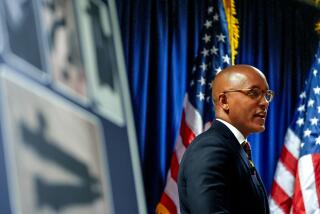Celebrity Is Often Its Own Best Defense
The Michael Jackson case is the latest celebrity trial designed for public consumption -- and the publicâs appetite has never been so ravenous. Sunday nightâs â60 Minutesâ interview with the pop star accused of child molestation just fed the beast.
Celebrity trials operate on their own set of rules. They give the public a glimpse into the lives of the rich and famous -- lives where common fetishes or fantasies are overindulged and assume monstrous proportions.
In California, the public has been fed an almost constant diet of celebrity cases involving sexual escapades and perversions great and small. The roster of celebrity defendants is a whoâs who of the Hollywood elite stretching over a century, including Roscoe âFattyâ Arbuckle, Errol Flynn, Charlie Chaplin, Roman Polanski, Hugh Grant, Charlie Sheen and many others.
Accusations of corrupting or abusing the young are particularly prominent in these scandals. Actress Joan Crawford had a public affair with an underage actor, Jackie Cooper. Chaplin had a well-known penchant for underage girls; he married girls who were 18, 17 and 16 years old.
A review of these cases reveals that the usual practices in criminal trials often do not apply when celebrities are involved. For example, in noncelebrity trials, the defense struggles to make the jury more sympathetic toward the defendant by emphasizing common habits and interests. Defendants dress in understated ways and their spouses are asked to wear no jewelry in court. But celebrity defendants often emphasize their wealth, hoping to establish the motive of greed on the part of their accusers, claiming that the charges are fabrications by people trying get rich quickly.
The defense in the Jackson case has already suggested that once access to Neverland Ranch ended for the alleged victim and his mother, they decided to try to take part of the dream back through litigation.
Such corrupt motives have been central to past celebrity defenses. In Arbuckleâs 1921 trial, the most famous silent film star of the time was accused of brutally raping a showgirl, Virginia Rappe, who was found in a coma and later died. The public was obsessed with reports of the debauchery and indulgences of Arbuckle, the eraâs highest-paid actor.
The world heard how Arbuckle and his friends traveled in his specially built Pierce Arrow touring car. Though certainly no Neverland Ranch, the carâs built-in restroom and bar filled with illegal booze were beyond the imagination of most citizens in the 1920s.
Arbuckleâs accuser was a self-professed friend of Rappeâs, Maude Delmont, who insisted that Rappe implicated Arbuckle in her final words. In what should be a lesson for the Jackson prosecution team, the Arbuckle case showed that no prosecution is stronger than its witnesses. Arbuckleâs defense team found a telegram from Delmont to two friends telling them that âwe have Roscoe Arbuckle in a hole here. Chance to make some money out of him.â The defense further showed that Rappe had lived what today would be called âthe vida loca.â
This fed a common public reaction to celebrity trials. Though the public is often repulsed by the lifestyles of celebrities, harsh judgment is cast upon their accusers too. Victims and witnesses are often portrayed as motivated by money or fame -- an accusation that proved correct regarding Delmont.
The Jackson team has already laid the foundation for a type of Arbuckle defense -- stressing statements made by the boy and his mother that previously exonerated Jackson.
Sometimes, a celebrityâs reputation can actually be an asset. Consider the case of Errol Flynn. The swashbuckling actor was well known in Hollywood for his preference for underage girls. Indeed, in a frank acknowledgment of the laws of statutory rape, Flynn often called his young girlfriends his âSan Quentin Quailsâ or JBs (for jail bait).
The trial of Flynn for the statutory rape of two teenage girls electrified a war-weary public and liberated a sex-shy media. The evidence and Flynnâs reputation were consistent with the testimony of the two alleged victims, Betty Hansen, 17, and Peggy LaRue Satterlee, 15. Flynn in many ways was saved by his reputation as a rake -- a reputation that painted his alleged victims as willing participants. Flynnâs lawyers hammered away at the girlsâ interest in Flynn and their alleged encouragement of the encounters (despite the fact that consent is not a defense against statutory rape).
In one of the most savage moments, Flynnâs attorneys revealed that Satterlee had had an affair before the alleged rape and later an abortion -- a social stigma that all but destroyed her credibility for a jury in 1943. Adding insult to injury for these girls, âin like Flynnâ became a popular expression after the trial for a man lucky with ladies.
For Jackson, this tactic may be brought to its most extreme form. The gender-bending, child-obsessed star may be seen as a walking warning to any cautious parent. How is the jury to view as a witness a mother who took her son for sleepovers with Jackson?
Ultimately, a jury may have a hard time understanding a maternal motive for exposing her son to Jackson but it can well understand a financial motive. In other words, Jacksonâs persona could prove to be not his downfall but his salvation in the context of a celebrity trial.


